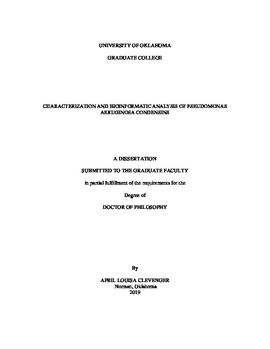| dc.description.abstract | DNA is organized within chromosomes not only to permit a large amount of DNA to occupy a very small space, but also to serve essential functional roles. Varied levels of organization enable proper DNA replication, repair, transcription, segregation and cell division. A key player in maintaining proper global organization of the chromosome are condensins. Condensins dynamically interact with DNA and play critical roles in chromosomal duplication functions, including DNA segregation. Pseudomonas aeruginosa (PA) is a virtually ubiquitous gram-negative bacterium capable of inhabiting a wide range of ecological niches, including the human host. PA has the ability to differentiate into different physiological states allowing it to adapt to different environments, a key aspect of infection progression. Therefore, a better understanding of how these genes are regulated and capable of switching into different physiological states could significantly help in preventing and treating PA progression during infection.
Typically, condensins are known for their roles as chromosomal organizers and maintainers. One of the key findings in this study showed that they are also global regulators of gene expression where phenotype is both context and strain dependent. Here, we investigated the roles that PA condensins, SMC-ScpAB and MksBEF have on cell physiology and gene regulation in PA.
Transcriptomic analysis of PAO1 condensin deletion mutants revealed substantial changes in gene expression, in particular, for pathways involved in virulence. Many of these affected pathways were found to be oppositely regulated for ΔmksB and Δsmc, reminiscent of acute and chronic infection phases, respectively. Overall, each condensin deletion strain, showed a unique transcriptional profile implicating different regulatory pathways. Physiological studies on condensin deletion strains in PAO1 were in line with transcriptional analysis showing opposite differentiation states [1]. Using biofilm formation as a reporter for mksB phenotype, complementation studies unexpectedly revealed that the link between MksB and biofilm is context dependent. Using the degron system and ATPase MksB point mutations, MksB was confirmed to be directly linked to biofilm formation while complementation of the mksB gene after a full mksB deletion, however, was not possible. These results indicate significant changes to cis effects in the mksB region of the chromosome or even secondary consequences resulting from the mksB deletion.
ATPase MksB point mutations also revealed that the link between MksB and biofilm is conformational dependent. Two of the three generated ATPase MksB mutants, E864Q and S829R, reflected severe biofilm defects. Strikingly, a third mutant, D864A, was capable of full biofilm function. These results reveal that MksB intermediate conformations, rather than ATPase activity, is relevant for MksB regulatory function. Notably, physiological studies on PA14 condensins revealed that condensin phenotypes are largely strain dependent. Although slight deviations were seen for growth studies, condensin deletions revealed a much smaller effect than PAO1. Overall, this implicates significant differences in how condensins are integrated into the regulatory networks of the PAO1 and PA14 strains and highlights a possible fortuitous integration by condensins into the regulatory system of PAO1.
Strikingly, there is a significant inversion in the chromosome of the PAO1 substrain PAO1-UW at two rRNA sites separated by 2.2 Mb [5]. This inversion altered the layout of key markers in segregation (the chromosomal dimer resolution site, dif, found at the terminus of segregation) and replication (the origin of replication, oriC) illuminating asymmetry in the PAO1 chromosome. These markers are highly coordinated with nucleotide bias or (GC skew), which is an underlying signaling code in bacterial DNA where there is an abundance of guanines on the leading strand and cytosines on the lagging strand. Typically, the terminus of replication and dif align as most bacterial chromosomes are symmetric, making differentiation between their underlying processes difficult.
Therefore, we used the asymmetric PAO1 chromosome as a model to study the coordination between segregation, replication and nucleotide usage bias. Experimentally, replication was found to terminate opposite from oriC while segregation terminated at the asymmetric dif [5]. GC skew analysis showed switches in polarity at the oriC and dif sites, while the terminus of replication was almost 700 kbp away. Overall, this shows a lack of coordination between replication and segregation and that nucleotide bias is aligned with both processes. Using location markers for replication and segregation, we bioinformatically analyzed all complete sequenced bacterial chromosomes from NCBI [6]. Our findings show that nucleotide bias is correlated with dif but not the terminus of replication for all chromosome types, implicating the segregation process as a contributor to the nucleotide bias phenomenon. | en_US |
